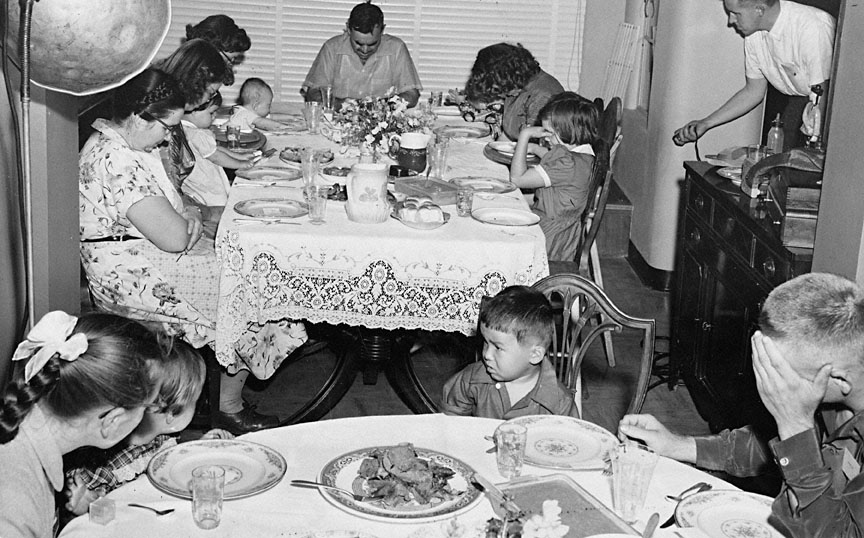- Catalog No. —
- OHS SIF 519
- Date —
- October 16, 1955
- Era —
- 1950-1980 (New Economy, Civil Rights, and Environmentalism)
- Themes —
- Government, Law, and Politics
- Credits —
- Oregon Historical Society
- Regions —
- Willamette Basin
- Author —
- Oregon Journal Collection
Holt Family Meal
This photograph is one of many which accompanied Oregon Journal coverage on October 16, 1955 of the much publicized adoption in which Harry and Bertha Holt, white evangelists from rural Oregon, added eight Korean infants and toddlers to their already large family of six biological children. The caption identified the event as the first meal the entire Holt family enjoyed together.
The Holts decided to adopt after meeting representatives of World Vision, a Christian relief group that had been raising money for Korean War victims. The organization alerted the Holts to the hardships faced by thousands of orphaned “GI Babies,” children fathered by American soldiers during the war. As mixed-race individuals born without fathers present, these children were sometimes cruelly stigmatized in Korea.
Prior to 1948, U.S. adoptions from other countries were infrequent. Adoption agencies had long encouraged the practice of matching children’s and parents’ physical and racial traits. Despite a gradual rising interest in international and biracial adoptions beginning after World War II, U.S. immigration laws and quotas kept adoptions across international lines at a minimum. When the Holts decided to carry out the multiple adoptions in 1955, restrictions within the Refugee Relief Act of 1953 limited their ability to do so.
Although it took a special act of Congress, the Holts successfully lobbied for legislation that allowed them to adopt the eight Korean children. The couple welcomed media attention that fanned public interest in international adoptions. In fact, the same day Oregon Journal photographers took this photograph, newsreel cameramen—one of whom is captured in this photo—had the Holts recreate for film the homecoming scene that took place the evening before.
So successful was the press coverage that it launched a new philanthropic career for the Holts. With wealth acquired from lumber and farming pursuits in Creswell, Oregon, the Holts started a large-scale adoption program that placed Korean orphans with eager American families. Newspapers reported glowingly on their “babylift” operations, showing Harry Holt “lifting” orphans and escorting them via private aircraft to parents who had never met them.
Over time, the Holts modified their methods in order to meet evolving regulations governing international adoption procedures. The Holt Adoption Agency—which later became Holt International and still exists today—eventually grew to include adoptions from many other nations. However, its early focus on Korea helped to make adoptions from that country the most common in the United States from the 1950s through the 1980s.
Further Reading:
Adamec, Christine A. and William L. Pierce. The Encyclopedia of Adoption, 2nd Edition. New York, N. Y., 2000.
Aeby, John. A Home for Every Child. Eugene, Oreg., 1986.
Written by Sara Paulson, © Oregon Historical Society, 2006.
